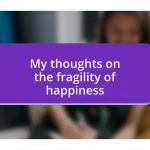Key takeaways:
- Complex villains emerge from deep-rooted motives and traumas, challenging the simplistic notions of good and evil.
- Understanding the psychological traits and backstories of villains fosters empathy and reflects societal issues, making them relatable and memorable.
- Creating compelling villains involves exploring their flaws, vulnerabilities, and internal conflicts, transforming them into multi-dimensional characters that resonate with audiences.

Understanding villain complexities
When I reflect on villain complexities, I realize they often stem from deep-rooted motives and personal traumas. For instance, I’ve encountered stories where a seemingly evil character was driven by a desperate need for acceptance after experiencing abandonment. This emotional depth invites the audience to ask: can we really blame them for their choices, or is there a part of us that understands their pain?
Exploring these layered personalities forces me to reconsider the nature of good and evil. I recall a villain from a novel I read, who would meticulously plan their actions yet struggled with guilt stemming from a childhood filled with neglect. It’s fascinating how these intricacies challenge our perceptions, isn’t it? One moment, we’re rooting for a savior, and the next, we find ourselves empathizing with someone we’re meant to despise.
Villains often mirror our own fears and failures—do they not? The complexities in their character remind me of a friend who seemed ruthless in business yet was fiercely loyal to close ones. Reflecting on that experience helps me explore how our own motivations can blur the lines between hero and villain, exposing the vulnerabilities that lie beneath. Villains are not merely obstacles; they offer reflections of our inner conflicts and moral dilemmas.

Importance of nuanced villains
Nuanced villains are essential because they elevate storytelling beyond simple good versus evil narratives. I remember a film where the antagonist was not just a foil for the hero but a tragic figure caught in circumstances far beyond their control. This perspective allowed me to see villainy in a different light; instead of merely vilifying the character, I found myself pondering the choices and experiences that led them down that path.
- They challenge our perceptions of right and wrong, prompting deeper moral questions.
- Their complexities often make them more memorable and relatable than one-dimensional heroes.
- Understanding their motives can foster empathy, encouraging us to explore our own flaws and biases.
- They often reflect societal issues or human experiences, offering commentary on real-world struggles.

Psychological traits of complex villains
The psychological traits of complex villains often reveal a blend of intelligence, emotional depth, and vulnerability that captivates me. I recall a character I encountered in a graphic novel who was incredibly strategic, planning his moves like a chess game. Yet, beneath this brilliant facade, he grappled with severe anxiety—his overwhelming need for control stemmed from a chaotic childhood. It’s this juxtaposition that makes complex villains intriguing; they exhibit traits like obsession and insecurity, blurring the lines between villainy and humanity.
When I think about it, many complex villains display traits of narcissism, often masking profound insecurities. For example, I once read about a villain whose external charm hid a crippling fear of rejection. This characteristic resonated with me, as I have met people in my life who project confidence yet silently struggle with their self-worth. Their unpredictability is a testament to the intricate layer of their psychological profile, pulling the reader into their internal battles and making us wonder what drives their actions.
One striking psychological trait that often stands out is moral ambiguity. This trait evokes empathy, even in the darkest moments. I remember feeling torn between frustration and pity for a villain who, despite her cold methods, cared deeply for her family. It made me question: How can someone committed to harm also possess love? This duality reflects the complexities we all face, making villains not just characters, but personal mirrors of our struggles.
| Trait | Description |
|---|---|
| Intelligence | Strategic thinking often masked by emotional chaos. |
| Narcissism | Defensive facade hiding insecurities. |
| Moral ambiguity | Duality of love and harm creates empathy. |

Examples from literature and film
One of my favorite examples of a complex villain comes from Shakespeare’s Macbeth. Macbeth’s character progression captivates me; he transforms from a brave soldier to a tyrant consumed by ambition and guilt. I often wonder how an ordinary person can spiral into such madness—it’s a potent reminder that even the noblest intentions can lead to devastating choices when ambition takes the wheel.
Another striking character is Walter White from the series Breaking Bad. Initially, he seems like a sympathetic figure—a high school teacher turned meth producer to secure his family’s future. But over time, I found myself questioning his moral compass as he manipulates those around him. This reveals a truth that resonates deeply: how often do we let our justifications blur the lines of our own ethics?
In cinema, the Joker stands as an icon of chaotic complexity. His unpredictable nature and dark humor force me to confront the pain and trauma that shaped him. I can’t help but ask—what societal failures allowed such a character to emerge? The Joker’s presence in film is a stark reminder that villainy often reflects broader human experiences, challenging us to dig deeper into the roots of their chaos.

Analyzing motivations and backstories
When analyzing the motivations and backstories of complex villains, it’s fascinating to see how their experiences shape their actions. I once found myself deeply engrossed in a book where the antagonist was driven by a dark family legacy. Growing up overshadowed by a sibling’s brilliance, their need for approval twisted into a thirst for power. Isn’t it intriguing how some people transform their pain into a desperate quest for dominance?
I remember watching a film that portrayed a villain torn between loyalty and ambition. Her backstory revealed a traumatic betrayal that led to her ruthless demeanor. It made me ponder—how often do our past experiences dictate our choices? I find that many of us can empathize with the feeling of betrayal, even if our responses differ. This familiarity with emotional turmoil brings a layer of relatability to complex villains that I can’t ignore.
Sometimes, backstories reveal a deep-seated desire for connection masked by villainy. I encountered a character who resorted to villainous acts to form a bond with a lost parent. This made me reflect on my own attempts at connection and how far I might go to fill an emotional void. It raises a question: are we all capable of crossing moral lines when driven by love and loss? Understanding these motivations allows us to see villains not just as adversaries but as flawed individuals navigating their inner turmoil.

Lessons for writing compelling villains
Creating compelling villains requires us to dig deep into their psyche. I’ve discovered through my writing that the more flawed and relatable they are, the more intrigued I become. For instance, I once crafted a character who committed terrible acts yet yearned for familial approval. This juxtaposition of love and villainy made me ponder the complexities of unconditional loyalty: how far would I go to seek validation?
Another lesson I’ve learned is the importance of making villains multi-dimensional. I remember drafting a scene where my antagonist revealed their vulnerabilities, shedding light on their past trauma. It was eye-opening; I realized that even in their darkness, there was a spark of humanity. Can we truly condemn someone when their actions stem from pain? This narrative choice transformed my villain from a mere obstacle into a character I could almost empathize with.
Ultimately, I’ve found that contrasting desires can create riveting conflicts within a villain. A character I wrote once found herself torn between loyalty to her friends and an insatiable hunger for power. This internal struggle made her more compelling because it mirrored the conflicts many of us face. Doesn’t that show how power can corrupt even the kindest of hearts? Understanding this dynamic allows us to create villains that not only engage readers but also reflect the complexities of human nature.














